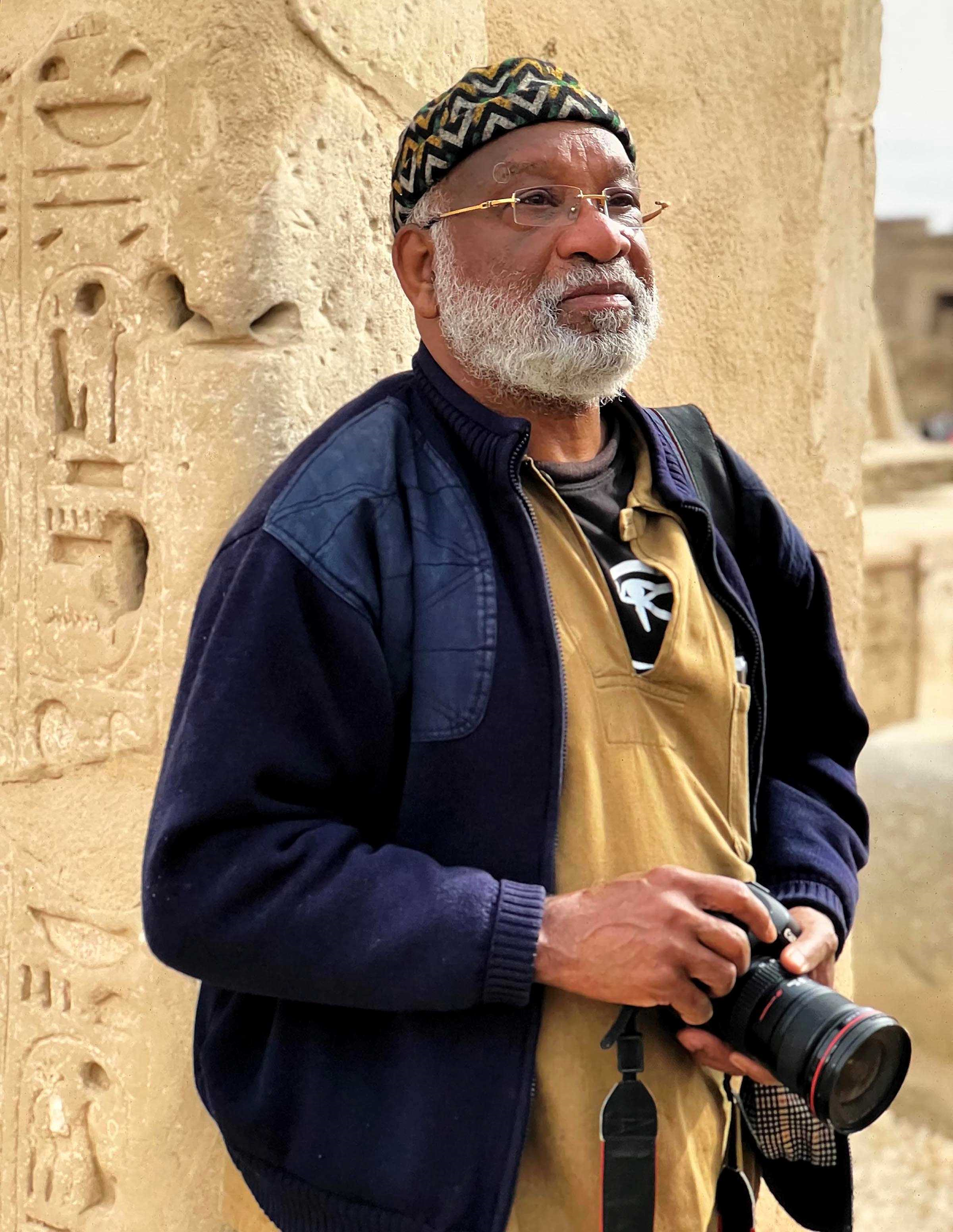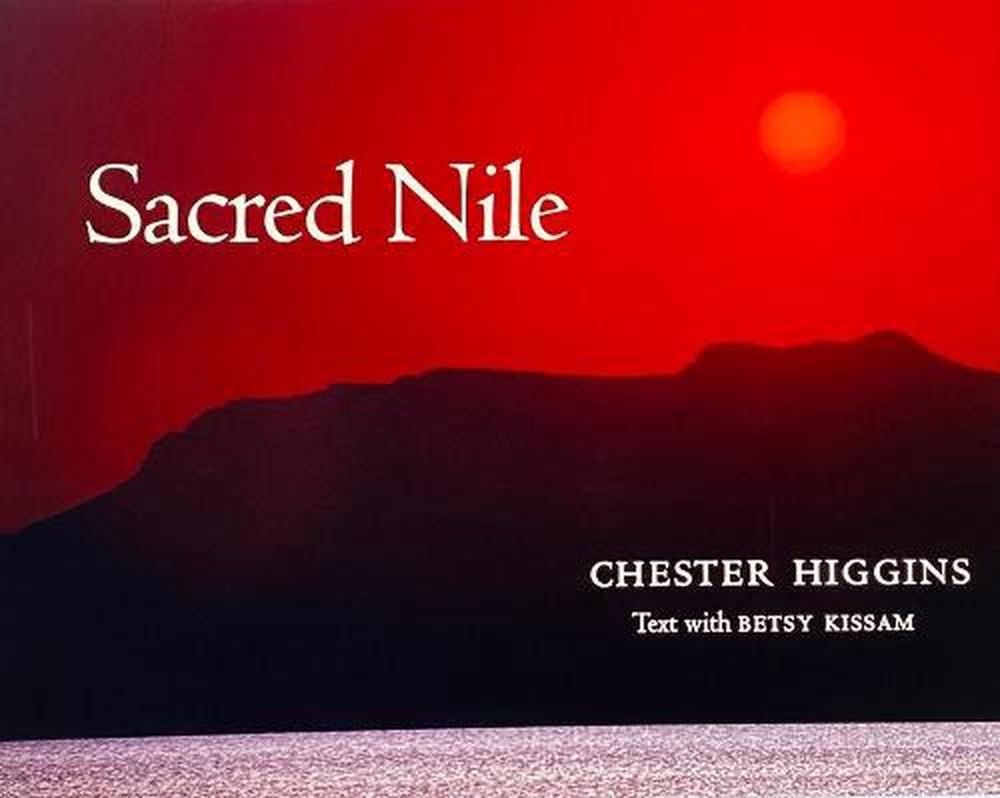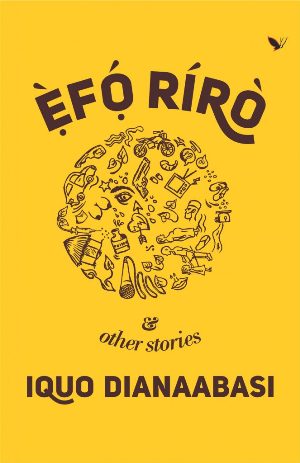

REVIEW OF SACRED NILE

On Saturday 6th May 2023, I interviewed Chester Higgins. He is the renowned African-American photographer who was inducted into the International Photography Hall of Fame on 4th November 2022. He joins other celebrated artists there, among them Robert Capa, Bill Brandt, Annie Leibovitz and Henri Cartier-Bresson. It is no wonder he's counted among the greats: his legendary 4-decade career at the New York Times precedes him; his body of photographic work which extends over 50 years of practice prior to, during and beyond the Times, is a source of pride not only to people of African descent but to the global community of lovers of photographic art. There is a sanctity in the way he documents the African-American and African experience of the world. An ineffable quality permeates his photographs. Chester Higgins would call this quality, spirit. With his lens, he accesses the spirit of his subjects.
His books are critically acclaimed. They include: Drums of Life: A Photographic essay on the Black Man in America; Echo of the Spirit: A Photographer's Journey; Feeling the Spirit: Searching the World for the People of Africa and Ancient Nubia: African Kingdoms on the Nile.

Click here to buy
I requested an interview to discuss Sacred Nile, his latest book, published in 2021 by March Forth Imprint, New York. This book was born of Chester Higgins's passion for Africa and in the words of Jessica Harris, culinary anthropologist and Time 100 honouree, it is the magnum opus, "Chester Higgins was born to make".
Notes on Ancient Names, Children of the River, Divine Nature, Sacred Space, Drama of Ritual, Iconography, Into the Night. These are the evocative titles headlining the main content of the work and it was with the wonder they elicit that I began my journey into the Nile Region guided by the author. That it would be a journey into the unexpected I knew already and I fully expected to find phenomena that would take my breath away.

Google Images
I didn't have to wait. The Holy Family of Karnak. The stone engraving takes up the expanse of the inner cover page. It depicts King Ramses II kneeling to be anointed by the seated Holy Father, the supreme divinity, Amen, and the Holy Mother Mut. Their son, Khonsu, stands behind his father. Housed in the Temple of Amen located in Karnak on the East Bank of Luxor, Egypt, the engraving dates back to 14th century BCE.

Here you have the only god AMEN seated. Standing behind AMEN is his/their son
KHONSU and standing in front is his wife MUT. In between Holy Mother MUT and
the Holy Father AMEN bending on his knees giving honor is King Ramses.
image courtesy of Chester Higgins
The Holy Family? The Amen? An anointed son?

I quickly turned overleaf and read on - reading closely, remembering to pause to admire the photographs Higgins took during his travels through the region. He is an excellent guide, introducing us through a multiplicity of images to a vast panoply of people and places: historical kings and queens, fishermen of today navigating the Nile in boats made of papyrus; priests clad in spare white kaftans, others clad in rich regalia. Harpists of Kush (Ethiopia) play an intriguing harp named after the Jewish King David. Local worshippers and African-American pilgrims offer incense to deities and I see in the religions of Kemet (Egypt) and Nubia (Sudan), a strong emphasis on the ritual of anointing - the ritual which prefaces the book.
Commanding the pages of Sacred Nile are religious rituals, the iconography of sacred art, sculptures and bas-reliefs, royal tombs, ruins of glorious temples and the mesmerizing landscape of the region. Revealed to the reader but hidden from the view of strangers, a plethora of ancient Ethiopian churches hewn out of rock resemble a network of secret temples. Out of these, the 13th century Church of Gabriel and Raphael, shot against the glittering canvas of a starry night, transfixes me. And the pharaohs - massive, implacable, sunlit, encompassed by endless sands rippled by morning winds - what a sight the pharaohs are to behold.
Across the span of 229 pages, the veteran photographer arrests our vision with images recording our religious roots. They combine with Betsy Kissam's rich text to build a compelling case for the promotion of Sacred Nile as a "guiding compass" for an exploration of "the religious and cultural contributions of one of the most - if not the most - significant centers of human history".
[From Sacred Nile. Comment by Thierno Thiam, Chair of Tuskegee University's Department of History]

Google Images
It's important to read the introductory Notes on Ancient Names. They provide brief but valuable context about the history and political culture of Kemet- the Black Land. There is an analytical chart of hieroglyphics - the Sacred Language of Priests. The devastating impact of 300 years of Greek occupation on the language and culture of Kemet, is brought to our attention. The author throws open a window onto one of the most epochal moments in the history not only of the African continent but of the world: the successful military campaign waged by General Napoleon Bonaparte in 1798 and following it, the 4-year occupation of Egypt by France, and during that period, the discovery of the Rosetta Stone - a 196 BCE royal decree written in demotic and hieroglyphic scripts and ancient Greek.

French military leader who conquered much of Europe in the early 19th century
Google Images
The Notes bring on stage 18th century French linguist Jean-François Champollion and his team of scholars who in 1822 deciphered the hieroglyphic and demotic scripts of the Rosetta Stone. The decoding of the Rosetta Stone bequeathed to scholars across the world - who would become known as Egyptologists - the keys to unlock voices hidden inside the theological documents of Kemet and by unlocking those voices, unveil to an enthralled world, the extraordinary culture of ancient Egypt.

image courtesy of Chester Higgins
In total, there are 11 sections in Sacred Nile. I approached them as though each were a large, heavy casket containing valuable treasure - knowledge mined from 50 years of exploring the landscape, cultures, motifs, common visions and practices that bind the spiritual histories of Kemet (Ancient Egypt), Nubia (Sudan) and Kush (Ethiopia).
Betsy Kissam wrote the Acknowledgments - brief but glowing tributes to all those who made the massive undertaking possible. In Praise for Sacred Nile, there is a wonderful diversity of scholars.

Rabbi Sholomo Ben Levy, Jessica B. Harris (culinary historian), Maaza Mengiste (Ethiopian-American writer), Felipe Luciano (poet, community activist, journalist)
Tefera Gedamu (major personality in the Ethiopian media scene), David Henry Hwang (American playwright, librettist, screenwriter), Raoul Peck (Haitian filmmaker, Haiti's Minister of Culture from 1996 to September 1997)
Google Images
Commendations have come in from: Rabbi Sholomo B. Levy, President of the International Israelite Board of Rabbis, New York; Felipe Luciano, Afro-Puerto Rican poet; Haitian filmmaker and César Award winner, Raoul Peck; curator at the Whitney Museum of American Art, Carrie Springer; Ethiopian television host, Tefera Gedamu and celebrated journalist and food writer, Jessica Harris. On the back cover, there is praise from David Henry Hwang, American playwright and Obie Award winner and from Maaza Mengiste, Ethiopian- American author of the acclaimed novel, The Shadow King.

King Ramses located on the West Bank of the Nile in Luxor called the Ramsseum.
image courtesy of Chester Higgins

Merge these tributes with the roll call of Acknowledgements. What emerges is a pantheon of experts linked by their diversity and by their powerful cause: to reclaim from the colonizers of Africa, Africa's agency, Africa's intellectual and spiritual sovereignty and attendant on this, Africa's dignity. As a guiding compass for the study of our spiritual roots, Sacred Nile has received a broad mandate from these men and women - Egyptologists, historians, anthropologists, theologians and other relevant experts who have contributed either to the making of this book about our common spiritual heritage or as peer reviewers, have critiqued it.
I was particularly struck by the comment made by Solange Ashby, an Egyptologist working at the University of California, Los Angeles. On the back cover of the book, Ashby raises the issue of contestation on the subject of "cultural and religious connections between the lands that border the Nile: Ethiopia, Nubia, and Egypt from the dawn of history down to the present time."

expertise focuses on language and religion in ancient Egypt.
Google Images
That Ashby reminds us that much of the knowledge presented by Chester Higgins and Betsey Kissam in Sacred Nile is 'rejected by many mainstream Egyptologists' is important, but so is the declaration of assurance that immediately follows it: "as [mainstream Egyptologists] become more familiar with other African cultures, religious traditions, and languages, the connections described in this book will be confirmed in academia."
What makes this book hard to rival is the sheer scale and splendour of the text and images. What will make the case the author has built about our spiritual lineage hard to dismiss lies not only in the mountain of evidence showcased; it lies - importantly - in the rich bibliography he has passed on to the intrepid archaeologists and detectives amongst us. The Related Readings section contains the tools necessary for a self-guided examination of our religious heritage, our spiritual origins in Africa and of the significance of the Nile Region in all of this.
No-one presents the justification for the book better than Chester Higgins who describes his epic as a "visual record of faith". Throughout the work he makes his argument but nowhere is he more poignant about his mission than in The Journey, the section which launches it:
"Sacred Nile is my portrait of the spiritual imagination and the genesis of faith in Africa. Ancient records left in stone detail Africa's philosophical quest to wrestle with the seminal issues of who we are, where we are, and what is our purpose_With this visual record of faith, I propose to redefine the beginnings of belief at its earthly place of origin, along the Sacred Nile. Coming face to face with the monumental remains of Ancient Egypt, I realized that the African foundation of religion had been obscured by miseducation. The story of Ancient Egypt's enduring and innovative civilization has been uprooted from the memory of the African people"
"The complexity as well as the strength and originality of the cultural legacy, threading through ancient and contemporary societies along the Nile, challenges the imagination."
This quote is taken from Children of the River, the section of the book which presents the relationship between the indigenous peoples and the mysterious, unpredictable Nile River on which their physical lives depend. But Children of the River extends the relationship between man and water into the spiritual realm. When Higgins highlights a narrative common to Africans everywhere, our 'walk with the Spirit', in the minds of Christian readers, he has evoked the Holy Spirit of the Bible, the One to whom we refer as the River of Life - the Living Water we drink to irrigate our souls. Sharing Our Roots, the section's closing commentary, provides what for me is a most remarkable fact from the sumptuous trove with which this epic is laden. Gihon, meaning, of Genesis is the Amharic name by which the people of Ethiopia refer to the Blue Nile. Gihon is a Biblical river, a witness to the origins of humanity in the Garden of Eden and the second of four rivers watering it.

one god of the Sun whom they call WAKA come together at the sacred sycamore tree
on the shore of a volcanic lake in Bishoftu. For several days, they hold ceremonies
to Nature at the tree and nearby water. The tree represents the connection between the
ancestors and the living and water represents life.
image courtesy of Chester Higgins

Christians view the New Testament as the fulfilment of prophecies spoken by the prophets and of prophecies conveyed by means of what we term 'types' and 'shadows' strewn across the landscape of the Old Testament. These 'types' can be people or places or events; shadows can be storylines or themes. Old Testament 'types' and 'shadows' prefigure the New Testament coming of Christ, His Mission and Life, His sacrificial death and His doctrine ie what His Life and Death mean for the world.
What a deeply satisfying experience it has been for me to explore through the pages of Sacred Nile the origins of the spiritual vision I embrace of the world. It has been a joy to explore the African origins of rituals which were as vibrant millennia ago as they are today in contemporary Christian practice. In the words of the poet Felipe Luciano, "It all started in Africa. Before Abraham, before Moses, before (the historical) Jesus, before Mohammed, there was the sacred passage of faith along the Nile River. Amen". It is thrilling to perceive through this unbroken continuum of ritual, the unity across millennia of those who have believed, those who believe, and those who will believe in the Spirit of Creation. We are the ones who have caught the revelation of who the Spirit is. We are the Church. Chester Higgins and Betsy Kissam have provided such meticulous documentation in this book. I return to it, marvelling at the wealth of research about the spiritual antecedents of Islam, Christianity, Judaism- the world's great religions.
During our talk, observing the way Chester Higgins speaks - with the passion of an evangelist - I am reminded all over again that at the tender age of 9 he entered public life as a Christian preacher and that right up until the age of 18, he practiced his faith as a (young) man of the cloth. Today, Chester Higgins may protest the legitimacy of aspects of the Holy Bible and denounce its demonization of ancient Egypt. He may and did point to excisions and distortions in its recording of history but nothing he said during our 2-hour discussion on 6th May 2023 has been able to undermine the wonder and excitement I felt reading his magnum opus. I pray the day will not come when I cease to marvel at the clarity with which the birth of Christ, His death and His resurrection were prefigured in the sacred traditions and art of ancient Egypt - part of what has been called the cradle of civilization.

In this tomb of a surgeon was found a statue to the Holy Mother Ast (Isis) holding her Holy Son, Heru (Horus).
According to Egyptian belief Isis a widow and virgin begged the Heavenly Spirit to impregnate her with a child.
Over the dead body of her husband she took the form of a bird and hovered over his privates and took the seed
of her dead husband who had been assassinated by his brother SET.
She later gave birth to Heru (Horus). When Heru grew of age, he formed an army and defeated his
evil uncle thereby taking the throne of Kemet and re-establishing Justice and Balance (Maat).
This is the first impossible birth or immaculate conception, 5000 years before Christ.
image courtesy of Chester Higgins
Stirring images and perspectives from Chester Higgins's 50-year excavation of spirituality in the Nile Region have opened my eyes to the shadow of Jesus Christ cast over time's unfolding chapters and beyond them. I see Christ's Blood flowing through the pages of human history from a Source outside and encompassing it. My reflections are birthing an inchoate but palpable image: an image of the Lamb slain before the foundations of the world.




